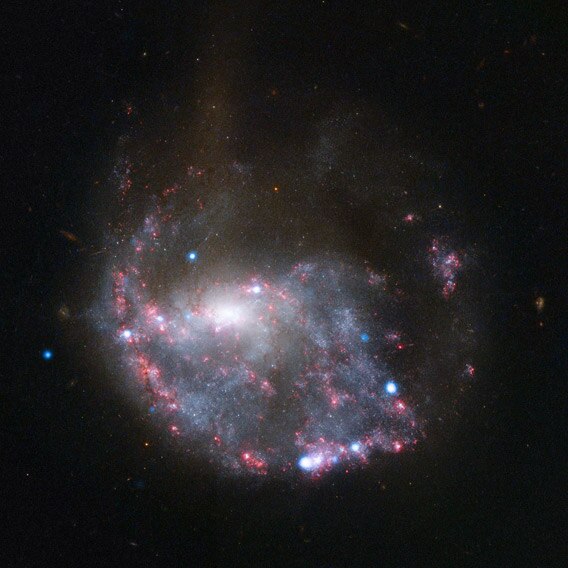Create a free profile to get unlimited access to exclusive videos, sweepstakes, and more!
A Galaxy Takes a Bullet to the Heart

Space is big. In fact, thatâs why we call it space.
OK, duh. But in general, most objects are small compared to the space around them. The distance from Earth to Venus, the nearest planet, is still thousands of times longer than the size of the Earth. The distance to the nearest star is 30 million times the Sunâs size. Thatâs like living in a house where your next-door neighbor is as far away as the Moon.
But galaxies are different. The distance to the nearest big galaxy, Andromeda, is less than 30 times the size of our galaxy. On a cosmic scale, galaxies are actually pretty crowded together. And that means they sometimes get in each otherâs way ⦠and sometimes that means they collide.
NGC 922 is one such galaxy. Itâs located about 140 million light years away, which is close enough to give us a great view of it. And thatâs cool, because about 300 million years ago, a smaller galaxy collided with and shot right through NGC 922, leaving behind chaos.
The image at the top of this post shows NGC 922. It's a combination of shots taken by the Hubble Space Telescope and the Chandra X-Ray Observatory. You can tell NGC 922 is a spiral, or at least itâs trying to be. But itâs a mess. The collision with the smaller galaxy was like a gravitational stone thrown into a pond, creating a ripple that expanded outwards from the center, compressing vast clouds of gas and dust, and triggering massive amounts of star formation in a lopsided ring tens of thousands of light years across. You can see that ring in pinkish-red, the color of hydrogen clouds being heated by newborn stars within them. Itâs a tell-tale sign that something big happened, which is as obvious to an astronomer as a siren going off.
The folks at Hubble put together a nice video explaining the disaster that shaped NGC 922:
That ring tells us a lot about how events went down. For example, we know the collision took the smaller galaxy only a little off dead-center through NGC 922. Collisions that are well off-center stretch out the galaxies, and even if the bullet had passed through the disk halfway to the edge the galaxy would be more distorted. Because that ring is so close to being a circle, the bullet must have passed very nearly through the heart of NGC 922.
The interloper was moving fast enough to blow right through NGC 922, and it can be seen in wider-field images quite some distance from its victim. Weirdly, though, while these two galaxies physically passed through each other, the chance that there was even a single collision between stars is pretty low. As I said, stars are far apart compared to their size, so when galaxies collide the stars go right on past one another. Itâs an odd thought.
But gravity knows no such isolation. The pull of each galaxy strongly affected the other, whipping up NGC 922 into this frenzy of star birth. Weâve seen this before in galaxies like the Cartwheel (shown here). In that case, the collision was more recent, and the bullet galaxy (the lower, bluer of the two smaller galaxies you see) is still pretty close. Eventually it will pull away, heading out into intergalactic space, its damage done.
The fate of NGC 922 is that the ring will likely break up into clumps as the material orbits the galactic center. The gas and dust will get sloshed around, and the galaxy will eventually lose its spiral structure, becoming a more or less featureless disk. Those kinds of galaxies, called lenticulars, are common in galaxy clusters where collisions are frequent. Thatâs no coincidence.
And just in case you think this is all very esoteric and has nothing to do with us, think again. The massive Andromeda Galaxy, every bit the Milky Wayâs equal, is on a collision course with us. The two galaxies are destined to collideâa train wreck on a cosmic scaleâand merge. Of course, this wonât happen for about another four billion years. So donât lose any sleep over it. But given the sheer beauty and coolness of NGC 922 and the Cartwheel, I think Iâd kinda like to witness that. What a sight that would be!


























